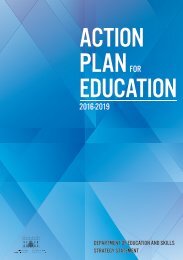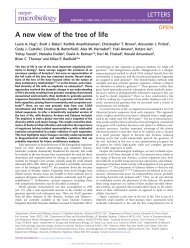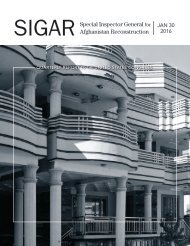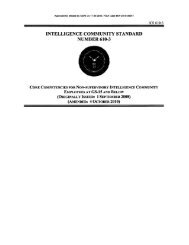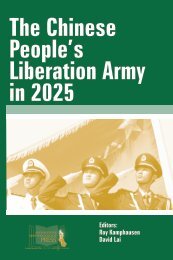The Joint Force in a Contested and Disordered World
JCS-JOE-2035
JCS-JOE-2035
Create successful ePaper yourself
Turn your PDF publications into a flip-book with our unique Google optimized e-Paper software.
Section 1 - <strong>The</strong> Future Security Environment 2035<br />
“<strong>The</strong> first, the supreme, the most far-reach<strong>in</strong>g act of judgment that the statesman <strong>and</strong><br />
comm<strong>and</strong>er have to make is to establish . . . the k<strong>in</strong>d of war on which they are<br />
embark<strong>in</strong>g.” 2<br />
<strong>The</strong> emerg<strong>in</strong>g security environment can be described by two dist<strong>in</strong>ct but related sets of challenges.<br />
<strong>The</strong> first is contested norms, <strong>in</strong> which <strong>in</strong>creas<strong>in</strong>gly powerful revisionist states <strong>and</strong> select non-state<br />
actors will use any <strong>and</strong> all elements of power to establish their own sets of rules <strong>in</strong> ways<br />
unfavorable to the United States <strong>and</strong> its <strong>in</strong>terests. <strong>The</strong> second is persistent disorder, characterized<br />
by an array of weak states that become <strong>in</strong>creas<strong>in</strong>gly <strong>in</strong>capable of ma<strong>in</strong>ta<strong>in</strong><strong>in</strong>g domestic order or<br />
good governance. <strong>The</strong>se tw<strong>in</strong> challenges are likely to disrupt or otherwise underm<strong>in</strong>e a security<br />
environment that will rema<strong>in</strong> largely favorable to the United States, but less overtly congruent with<br />
U.S. <strong>in</strong>terests.<br />
<strong>Contested</strong> norms <strong>and</strong> persistent disorder are not mutually exclusive. <strong>The</strong>y frequently <strong>in</strong>tersect <strong>and</strong><br />
<strong>in</strong>volve competition with a military dimension short of traditional armed conflict. This competitive<br />
behavior is characterized by ambiguity regard<strong>in</strong>g the nature of a particular conflict, opacity of the<br />
parties <strong>in</strong>volved, or uncerta<strong>in</strong>ty about relevant policy <strong>and</strong> legal frameworks. 3 In light of these<br />
changes, the ambiguous but still violent pursuit of political goals will be a normal <strong>and</strong> recurrent<br />
condition under which the <strong>Jo<strong>in</strong>t</strong> <strong>Force</strong> will <strong>in</strong>teract with any number of potential opponents over<br />
the next two decades.<br />
What follows is a description of how contested norms <strong>and</strong> persistent disorder will manifest <strong>in</strong> the<br />
future security environment across three thematic areas – <strong>World</strong> Order; Human Geography; <strong>and</strong><br />
Science, Technology, <strong>and</strong> Eng<strong>in</strong>eer<strong>in</strong>g. With<strong>in</strong> each of these areas, there are a number of<br />
conditions that will def<strong>in</strong>e <strong>and</strong> shape the future of conflict <strong>and</strong> war. Each condition encapsulates<br />
three or four militarily-relevant trends that describe the speed <strong>and</strong> direction of important changes<br />
<strong>in</strong> the security environment. <strong>The</strong> conditions are designed to provide a “snapshot” of the most<br />
critical security-related challenges that the <strong>Jo<strong>in</strong>t</strong> <strong>Force</strong> will likely confront <strong>in</strong> 2035. 4<br />
<strong>The</strong> first thematic area – <strong>World</strong> Order – describes how the <strong>in</strong>ternational system may change <strong>in</strong><br />
terms of state behavior, <strong>in</strong>terstate relationships, <strong>and</strong> the network of rules, norms <strong>and</strong> agreements<br />
(both tacit <strong>and</strong> explicit) that govern these relationships. <strong>The</strong> second thematic area– Human<br />
Geography – describes the quantity, characteristics, <strong>and</strong> distribution of human populations around<br />
the world <strong>and</strong> how chang<strong>in</strong>g demographics <strong>and</strong> culture may affect the future security environment.<br />
<strong>The</strong> third thematic area – Science, Technology, <strong>and</strong> Eng<strong>in</strong>eer<strong>in</strong>g – illustrates a set of likely<br />
technological advances <strong>and</strong> other scientific capabilities that may emerge over the next 20 years to<br />
impact the future security environment.<br />
2<br />
Carl Von Clausewitz, On War, (trans. Paret <strong>and</strong> Howard, 1976/1984) p. 88.<br />
3<br />
United States Special Operations Comm<strong>and</strong>, <strong>The</strong> Gray Zone (9 September 2015), p. 1, <strong>and</strong> Michael Mazarr,<br />
Master<strong>in</strong>g the Gray Zone, U.S. Army War College (December 2015).<br />
4<br />
This section of JOE 2035 was derived from a <strong>Jo<strong>in</strong>t</strong> Staff J-7 study titled Anticipat<strong>in</strong>g the Future Security<br />
Environment: Key Conditions for Future <strong>Jo<strong>in</strong>t</strong> <strong>Force</strong> Operations (May 2015).<br />
4




